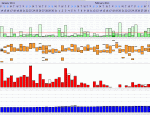Fixed pressure or auto pressure?
Fixed pressure or auto pressure?
Which one is best to use and why?
_________________
| Machine: ResMed AirSense™ 10 AutoSet™ CPAP Machine with HumidAir™ Heated Humidifier |
| Mask: Quattro™ Air Full Face Mask with Headgear |
| Additional Comments: Sleepyhead |
Re: Fixed pressure or auto pressure?
Which ever you prefer. I have a non auto, straight cpap that I use when traveling and I have my auto that I have been using the past month at home. Some swear the auto is the best and some straight cpap. If you have the software, I would test out both for a week each and see which one gives you the best numbers. That basically, is the best way to go....see which gives you the best therapy. We have had many discussions on the subject and it all comes down to YOU. Do some reading with the "search" button and you get more info.
Good luck
Nan
Good luck
Nan
_________________
| Machine: ResMed AirSense™ 10 AutoSet™ CPAP Machine with HumidAir™ Heated Humidifier |
| Mask: AirFit™ P10 Nasal Pillow CPAP Mask with Headgear |
Started cpap in 2010.. still at it with great results.
Re: Fixed pressure or auto pressure?
Thank you Nan.
_________________
| Machine: ResMed AirSense™ 10 AutoSet™ CPAP Machine with HumidAir™ Heated Humidifier |
| Mask: Quattro™ Air Full Face Mask with Headgear |
| Additional Comments: Sleepyhead |
Re: Fixed pressure or auto pressure?
Nan, what's your opinion of auto vs cpap? Do you do better with one or the other? What settings do you use for cpap and for auto? Mike's AHI's have been rising over the past month to the 4-5 range and I'm trying to experiment with both modes,and all I'm doing is confusing myself right now because I'm not seeing any improvement so far on either settings. He's getting clusters of events towards the latter part of the night,the early part of the night is great. I'll gladly take suggestions.nanwilson wrote:Which ever you prefer. I have a non auto, straight cpap that I use when traveling and I have my auto that I have been using the past month at home. Some swear the auto is the best and some straight cpap. If you have the software, I would test out both for a week each and see which one gives you the best numbers. That basically, is the best way to go....see which gives you the best therapy. We have had many discussions on the subject and it all comes down to YOU. Do some reading with the "search" button and you get more info.
Good luck
Nan
_________________
| Mask: Mirage Quattro™ Full Face CPAP Mask with Headgear |
| Additional Comments: 14/8.4,PS=4, UMFF, 02@2L, |
"Do or Do Not-There Is No Try"-"Yoda"
"We are what we repeatedly do,so excellence
is not an act but a habit"-"Aristotle"
DEAR HUBBY BEGAN CPAP 9/2/08
"We are what we repeatedly do,so excellence
is not an act but a habit"-"Aristotle"
DEAR HUBBY BEGAN CPAP 9/2/08
Re: Fixed pressure or auto pressure?
An auto can be set to be just CPAP. A CPAP only can not be set to auto. Auto cost more. But if you get auto and do not like it just set it to CPAP only. So really and auto is two machines in one.
Re: Fixed pressure or auto pressure?
Nan, what's your opinion of auto vs cpap? Do you do better with one or the other? What settings do you use for cpap and for auto? Mike's AHI's have been rising over the past month to the 4-5 range and I'm trying to experiment with both modes,and all I'm doing is confusing myself right now because I'm not seeing any improvement so far on either settings. He's getting clusters of events towards the latter part of the night,the early part of the night is great. I'll gladly take suggestions.[/quote]
Morning and Happy Easter to you and Mike, Dori.
I have used straight cpap of 11 for the past year and have been experimenting with my auto for the past month. I had it at 9/13 for the first week but noticed alot of vibratory snores in the later part of the night. Upped it to 10/13 and have been doing better and my ahi is under 1, usually about 0.3. I can't recommend any other way to help Dori, other than heep experimenting, I know it's hard with Mike's history. Linc does the same thing, he does better at straight cpap, but every month or so he does the auto thing, just to check his numbers. Give him a pm, he may have more insight for you as he has been switching over longer than I have. Since I now have Encore to check my therapy, I will be doing alot of experimenting too. I don't "feel" any different with either mode of therapy so must go by the numbers.
Good luck and keep me posted as to how Mike is doing.
Nan
Morning and Happy Easter to you and Mike, Dori.
I have used straight cpap of 11 for the past year and have been experimenting with my auto for the past month. I had it at 9/13 for the first week but noticed alot of vibratory snores in the later part of the night. Upped it to 10/13 and have been doing better and my ahi is under 1, usually about 0.3. I can't recommend any other way to help Dori, other than heep experimenting, I know it's hard with Mike's history. Linc does the same thing, he does better at straight cpap, but every month or so he does the auto thing, just to check his numbers. Give him a pm, he may have more insight for you as he has been switching over longer than I have. Since I now have Encore to check my therapy, I will be doing alot of experimenting too. I don't "feel" any different with either mode of therapy so must go by the numbers.
Good luck and keep me posted as to how Mike is doing.
Nan
_________________
| Machine: ResMed AirSense™ 10 AutoSet™ CPAP Machine with HumidAir™ Heated Humidifier |
| Mask: AirFit™ P10 Nasal Pillow CPAP Mask with Headgear |
Started cpap in 2010.. still at it with great results.
- Lizistired
- Posts: 2835
- Joined: Tue Dec 14, 2010 10:47 pm
- Location: Indiana
Re: Fixed pressure or auto pressure?
I have an S9 autoset, but I have narrowed my pressure and run it on cpap now. On auto it seemed to run at the top of whatever range was set at.
_________________
| Humidifier: S9™ Series H5i™ Heated Humidifier with Climate Control |
| Additional Comments: Swift FX sometimes, CMS-50F, Cervical collar sometimes, White noise, Zeo... I'm not well, but I'm better. |
ResScan: http://www.resmed.com/int/assets/html/s ... c=patients
ResScan Tutorial- http://montfordhouse.com/cpap/resscan_tutorial/
Machines Video: http://www.cpaplibrary.com/machine-education
ResScan Tutorial- http://montfordhouse.com/cpap/resscan_tutorial/
Machines Video: http://www.cpaplibrary.com/machine-education
Re: Fixed pressure or auto pressure?
Here is a recap of what I have done....
My titrated pressure is 10. Since january I have experimented with pressure ranges in apap and some in cpap.
I have read on the forum that the minimum pressure is critical.
So some time ago (a month or more) I arrived at setting my lower pressure at 10 and upper at 11. I watched what happened, checked where my 95% pressure and my maximum were. max was hitting 11. so I changed upper to 11.6....max was hitting 11.6.....so I changed upper to 12... max was hitting 12.....so I changed upper to 12.6....Voila!! In 2 weeks my ai has been lowest ever overall and I have only hit the max of 12.6 two times. Most of the time my max is at 12.4. So now I think I may have found the narrow range that is best for me.The pressure never goes below my titrated 10 and there is just enough upper range to get most of the events that need a higher pressure. My worst scores of all were when I set apap from 8-16. I have no idea WHY....just giving you the data. I have read on the forum that setting too wide a range in apap does not allow the machine the time to respond adequately. I think there are some people who do better on a very narrow range.
But I left each setting for at least 6-7 days before changing it. You cant get the info you need if you change it every night.
My titrated pressure is 10. Since january I have experimented with pressure ranges in apap and some in cpap.
I have read on the forum that the minimum pressure is critical.
So some time ago (a month or more) I arrived at setting my lower pressure at 10 and upper at 11. I watched what happened, checked where my 95% pressure and my maximum were. max was hitting 11. so I changed upper to 11.6....max was hitting 11.6.....so I changed upper to 12... max was hitting 12.....so I changed upper to 12.6....Voila!! In 2 weeks my ai has been lowest ever overall and I have only hit the max of 12.6 two times. Most of the time my max is at 12.4. So now I think I may have found the narrow range that is best for me.The pressure never goes below my titrated 10 and there is just enough upper range to get most of the events that need a higher pressure. My worst scores of all were when I set apap from 8-16. I have no idea WHY....just giving you the data. I have read on the forum that setting too wide a range in apap does not allow the machine the time to respond adequately. I think there are some people who do better on a very narrow range.
But I left each setting for at least 6-7 days before changing it. You cant get the info you need if you change it every night.
_________________
| Mask: Quattro™ FX Full Face CPAP Mask with Headgear |
| Humidifier: S9™ Series H5i™ Heated Humidifier with Climate Control |
Re: Fixed pressure or auto pressure?
Similar history with me. 8 cm minimum takes too long for the machine to get to where it needs to be to stop events.bayourest wrote: So now I think I may have found the narrow range that is best for me.The pressure never goes below my titrated 10 and there is just enough upper range to get most of the events that need a higher pressure. My worst scores of all were when I set apap from 8-16. I have no idea WHY
At 10 cm minimum it has a good enough head start that it can get to the stubborn events easily enough.
Most of the time I see 10 to 12 pressures but sometimes I have seen over 15 (not related to leaks). I just call them super duper events. Pressure variations have never bothered me so I just leave the max at 20. Machine won't go there unless it feels the need, doesn't wake me up and it is there "just in case".. For some people a tighter range works better. There is no one perfect way that works for everyone all the time. Each person has to decide which works best for them.
Minimum pressure is critical though. Response time has to be within the time to preempt the events. Can't be done at 5 or 6 or 8 minimum if the person needs some higher pressures. Even at minimum of 9 cm I have clusters of events that don't happen with minimum of 10.
_________________
| Machine: AirCurve™ 10 VAuto BiLevel Machine with HumidAir™ Heated Humidifier |
| Additional Comments: Mask Bleep Eclipse https://bleepsleep.com/the-eclipse/ |
I may have to RISE but I refuse to SHINE.
- rested gal
- Posts: 12880
- Joined: Thu Sep 09, 2004 10:14 pm
- Location: Tennessee
Re: Fixed pressure or auto pressure?
bayourest wrote:My titrated pressure is 10.
----
I have read on the forum that the minimum pressure is critical.
----
I arrived at setting my lower pressure at 10
--
so I changed upper to 12.6....Voila!! In 2 weeks my ai has been lowest ever overall and I have only hit the max of 12.6 two times. Most of the time my max is at 12.4.
----
My worst scores of all were when I set apap from 8-16. I have no idea WHY....just giving you the data.
The "WHY" -- I think you already answered the "why" in some of the other statements you wrote in your post...statements I quoted.
My guess about that "WHY" -- it was not because 16 was too high. Nor was it because the range you set was "wide." It was because the minimum pressure is the most important pressure to set "right."
8 was simply not enough to keep your airway open very well.
I believe It's the " 10 " for a minimum that was important for you. But you did need to give the max enough headroom -- which you weren't doing when you used 10 - 11. You finally gave the max enough room when you set the max at 12.6.
If you want to be a lab rat ... try this for a few nights. Try setting your machine's range for 10 - 20.
If you have leaks under control, I'll bet your machine is going to give you essentially the same nice low AHI using 10 - 20 as you are getting with your current range of 10 - 12.6. And since you said your machine usually stays below your max of 12.6, hitting that only a couple of times, I'll also bet that during a week of 10 - 20 you still won't see the machine hit, say 13 or 14, more than a couple of times.
Another little lab rat experiment to try... set your machine for CPAP mode at a straight pressure of 12. Bet you get a nice low AHI that way, too.
ResMed S9 VPAP Auto (ASV)
Humidifier: Integrated + Climate Control hose
Mask: Aeiomed Headrest (deconstructed, with homemade straps
3M painters tape over mouth
ALL LINKS by rested gal:
viewtopic.php?t=17435
Humidifier: Integrated + Climate Control hose
Mask: Aeiomed Headrest (deconstructed, with homemade straps
3M painters tape over mouth
ALL LINKS by rested gal:
viewtopic.php?t=17435
Re: Fixed pressure or auto pressure?
Yep, yep. What RG says. The machine won't go where it doesn't feel like it needs to go unless a leak is driving it.rested gal wrote: If you want to be a lab rat ... try this for a few nights. Try setting your machine's range for 10 - 20.
If you have leaks under control, I'll bet your machine is going to give you essentially the same nice low AHI using 10 - 20 as you are getting with your current range of 10 - 12.6. And since you said your machine usually stays below your max of 12.6, hitting that only a couple of times, I'll also bet that during a week of 10 - 20 you still won't see the machine hit, say 13 or 14, more than a couple of times.
Another little lab rat experiment to try... set your machine for CPAP mode at a straight pressure of 12. Bet you get a nice low AHI that way, too.
I also tried minimums of 11 and 12 and had no change in my AHI overall. No better or worse than setting the minimum to 10 and 10 cm was just more comfortable to use. I know I would have become used to the higher pressures but there is no need to use them if it makes no difference overall.
_________________
| Machine: AirCurve™ 10 VAuto BiLevel Machine with HumidAir™ Heated Humidifier |
| Additional Comments: Mask Bleep Eclipse https://bleepsleep.com/the-eclipse/ |
I may have to RISE but I refuse to SHINE.
Re: Fixed pressure or auto pressure?
I can't resist a lab rat challenge!! I really like to get data and so I'll give this a try and report back.
I have just come from Easter dinner and I think I'll pick a night when the wine has not been flowing!!
I have just come from Easter dinner and I think I'll pick a night when the wine has not been flowing!!
_________________
| Mask: Quattro™ FX Full Face CPAP Mask with Headgear |
| Humidifier: S9™ Series H5i™ Heated Humidifier with Climate Control |
Re: Fixed pressure or auto pressure?
Update: following Rested Gal's lab rat suggestion last night I changed my upper range from 12.6 to 20. minimum pressure remained at 10. My ahi was 0.7 and the a i was 0.4.....Software shows only 2 obstructives for the night (7 hrs). max pressure was 13.1 and 95% was 12.3. I cant seem to capture the detailed graphs in one snip but I might try to upload them (in 2 snips?) later today (no time now)
_________________
| Mask: Quattro™ FX Full Face CPAP Mask with Headgear |
| Humidifier: S9™ Series H5i™ Heated Humidifier with Climate Control |
Re: Fixed pressure or auto pressure?
Hi,
Executive summary:
Autos can provide increased control of AHI but come at the cost of tighter head gear, require better fitting masks and an increased and ongoing interaction, by the patient, to actively ensure leaks are controlled at the high end pressure range of the xPAP. Ultimately, patient response, to changes in their life and environment, under straight CPAP therapy will dictate the need for APAP.
Background:
An auto can adapt to changes in patient weight, fluid retention, medicine, sleeping position, weather changes, mood, stress and other things. Straight CPAP is easy, but changes, like those listed previously, show up as increases in the day to day AHI, patient compliance and sleep quality. Autos can, if set correctly, partly or fully adapt to these previously identified changes but, when the pressure rises so do the chances of leaks and leaks can disturb the patient's sleep and potentially fool the machine into pushing pressure even higher beyond what is necessary for effective therapy.
So, autos can be helpful but, they typically require a more active role on the part of the user (patient) to make sure that the mask is adjusted to take the sporadically higher pressures without leaking.
For APAP therapy, if the patient can clearly identify their normal range (Has anybody seen a single night sleep study correctly set the upper and lower pressure, you need too much data over weeks to months to really get it right) and the lower end set to prevent most all apnea, the "sweet spot," then opening up he high end a little will allow for pressure changes, caused by event like those previously listed. Patient comfort is increase because the higher pressure is only call upon as needed. The machine will mostly operate at the lower pressure band and only push higher when needed (or because of unconrolled leaks).
With straight CPAP the user should have the CPAP set just above the "sweet spot" minimum pressure and typically some distance below that maximum pressure that patient may sometimes need (and it will never go there it doesn't matter if you need it or not, the pressure is set and doesn't change hence CPAP.) The user's mask is set and periodically adjusted to not leak at this one pressure setting.
For any type of Auto Adjusting xPAP, the patient just needs to make sure that, no matter where the maximum upper limit is set, that their mask is fitted to prevent leaks at that maximum pressure upper limit. If the patient uses a Auto xPAP in auto mode, then the mask needs to be adjusted and periodically readjusted to hold that maximum pressure without leaking.
I suggest that the patient checks their leak free setting at least weekly (to account for any stretching in the headgear and things like weight change and water retention). The patient can easily do this by setting the APAP to the straight CPAP mode. Adjust the CPAP pressure to the Maximum APAP pressure (or for straight CPAP just adjust the mask as needed at the user's normal pressure). Lay down move around and adjust the headgear and mask so that they have no (or minimal) leaks. Reset the machine the to Auto mode and sleep. Then, once a week or so change the machine back to straight CPAP mode (now CPAP pressure should be already set to the user's max pressure if not adjust to the new maximum pressure) so that the patient can test and adjust again. Reset the machine to auto mode and repeat weekly.
So in summary, autos PAPs adjust pressure automatically, while the user sleeps, to deal with changes to the pressure that their bodies require to "splint open" the airway and improve or eliminate AHI. Straight CPAP is set to prevent most normal AHI but cannot respond to things that change in the patient's life and their environment that cause them to need increased pressure to prevent those same AHI. Auto PAPs can responde to these patient needs but require more patient interaction and data review to be set up and adjusted correctly and require chronic adjustment to the patient's headgear to ensure leaks are controlled over the range of pressure where their individual Auto PAP operates. So the choice of CPAP -vs- APAP is driven by the patient's AHI response to changes in themselves and their environment.
Cheers
Executive summary:
Autos can provide increased control of AHI but come at the cost of tighter head gear, require better fitting masks and an increased and ongoing interaction, by the patient, to actively ensure leaks are controlled at the high end pressure range of the xPAP. Ultimately, patient response, to changes in their life and environment, under straight CPAP therapy will dictate the need for APAP.
Background:
An auto can adapt to changes in patient weight, fluid retention, medicine, sleeping position, weather changes, mood, stress and other things. Straight CPAP is easy, but changes, like those listed previously, show up as increases in the day to day AHI, patient compliance and sleep quality. Autos can, if set correctly, partly or fully adapt to these previously identified changes but, when the pressure rises so do the chances of leaks and leaks can disturb the patient's sleep and potentially fool the machine into pushing pressure even higher beyond what is necessary for effective therapy.
So, autos can be helpful but, they typically require a more active role on the part of the user (patient) to make sure that the mask is adjusted to take the sporadically higher pressures without leaking.
For APAP therapy, if the patient can clearly identify their normal range (Has anybody seen a single night sleep study correctly set the upper and lower pressure, you need too much data over weeks to months to really get it right) and the lower end set to prevent most all apnea, the "sweet spot," then opening up he high end a little will allow for pressure changes, caused by event like those previously listed. Patient comfort is increase because the higher pressure is only call upon as needed. The machine will mostly operate at the lower pressure band and only push higher when needed (or because of unconrolled leaks).
With straight CPAP the user should have the CPAP set just above the "sweet spot" minimum pressure and typically some distance below that maximum pressure that patient may sometimes need (and it will never go there it doesn't matter if you need it or not, the pressure is set and doesn't change hence CPAP.) The user's mask is set and periodically adjusted to not leak at this one pressure setting.
For any type of Auto Adjusting xPAP, the patient just needs to make sure that, no matter where the maximum upper limit is set, that their mask is fitted to prevent leaks at that maximum pressure upper limit. If the patient uses a Auto xPAP in auto mode, then the mask needs to be adjusted and periodically readjusted to hold that maximum pressure without leaking.
I suggest that the patient checks their leak free setting at least weekly (to account for any stretching in the headgear and things like weight change and water retention). The patient can easily do this by setting the APAP to the straight CPAP mode. Adjust the CPAP pressure to the Maximum APAP pressure (or for straight CPAP just adjust the mask as needed at the user's normal pressure). Lay down move around and adjust the headgear and mask so that they have no (or minimal) leaks. Reset the machine the to Auto mode and sleep. Then, once a week or so change the machine back to straight CPAP mode (now CPAP pressure should be already set to the user's max pressure if not adjust to the new maximum pressure) so that the patient can test and adjust again. Reset the machine to auto mode and repeat weekly.
So in summary, autos PAPs adjust pressure automatically, while the user sleeps, to deal with changes to the pressure that their bodies require to "splint open" the airway and improve or eliminate AHI. Straight CPAP is set to prevent most normal AHI but cannot respond to things that change in the patient's life and their environment that cause them to need increased pressure to prevent those same AHI. Auto PAPs can responde to these patient needs but require more patient interaction and data review to be set up and adjusted correctly and require chronic adjustment to the patient's headgear to ensure leaks are controlled over the range of pressure where their individual Auto PAP operates. So the choice of CPAP -vs- APAP is driven by the patient's AHI response to changes in themselves and their environment.
Cheers
_________________
| Mask: Quattro™ FX Full Face CPAP Mask with Headgear |
| Additional Comments: Encore Pro, Backup-M Series BiPAP Auto. Set as ABiPAP 15I/9E AHI 0.2. Normally operates @ 12I/9E 1987 OSA diagnosis |
If your never go off on a tangent, you are doomed to live your life going around in circles.














